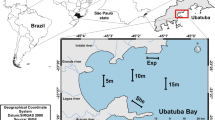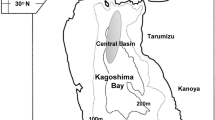Abstract
Tetraclita squamosa and Tetraclita japonica are common, intertidal barnacles. In Hong Kong, the population dynamics of the two species exhibited spatial and temporal variation on two semi-exposed shores. T. squamosa produced egg masses from May–June and annual settlement and recruitment occurred from June–July. In contrast, settlement and recruitment of T. japonica was sparse from March–May, but intensified in July–October. Mature gonads and egg masses were, however, only present from September–November, suggesting the larvae from the two settlement pulses originated from other locations as well as Hong Kong populations. Settlement intensity and post-recruitment mortality of the two species varied between sites, possibly due to spatial variation in free rock space, physical transport of larvae and abundance of food in the water column.












Similar content being viewed by others
References
Ballantine WJ (1961) A biologically-defined exposure scale for the comparative description of rocky shores. Field Stud 1:1–19
Bertness MD, Gaines SD, Wahle RA (1996) Wind-driven settlement patterns in the acorn barnacle Semibalanus balanoides. Mar Ecol Prog Ser 137:103–110
Cai R, Huang Z (1986) The reproductive characteristics of some Cirripedia in Hong Kong waters. In: Morton B (ed) The marine flora and fauna of Hong Kong and southern China II. Proceedings of the second International Marine Biological Workshop. Hong Kong University Press, Hong Kong, pp 945–960
Caroll ML (1996) Barnacle population dynamics and recruitment regulation in south central Alaska. J Exp Mar Biol Ecol 199:285–302
Chan BKK (2001) Studies on Tetraclita squamosa and Tetraclita japonica I: adult morphology. J Crustac Biol 21:616–630
Chan BKK (2003) Studies on Tetraclita squamosa and Tetraclita japonica II: larval morphology and development. J Crustac Biol 23:522–547
Chan BKK, Williams GA (2003) The impact of physical stress and molluscan grazing on the settlement and recruitment of Tetraclita species (Cirripedia: Balanomorpha) on a tropical shore. J Exp Mar Biol Ecol 284:1–23
Chan BKK, Morritt D, Williams GA (2001) Effect of salinity and recruitment on the distribution of Tetraclita squamosa and Tetraclita japonica in Hong Kong. Mar Biol 138:99–109
Chen K, Dong L, Cai R (1987) Biology and ecology of Tetraclita squamosa squamosa and Tetraclita japonica in Zhoushan waters (in Chinese). Acta Oceanol Sin 9:93–103
Connell JH (1961a) The influence of interspecific competition and other factors on the distribution of the barnacle Chthamalus stellatus. Ecology 42:710–723
Connell JH (1961b) Effects of competition and predation by Thais lapillus and other factors on natural populations of the barnacle Balanus balanoides. Ecol Monogr 31:61–104
Connell JH (1985) The consequences of variation in initial settlement vs post-settlement mortality in rocky intertidal communities. J Exp Mar Biol Ecol 93:11–45
Crisp DJ (1960) Factors influencing growth-rate in Balanus balanoides. J Anim Ecol 29:95–116
Crisp DJ, Patel B (1961) The interaction between breeding and growth rate in the barnacle Elminius modestus Darwin. Limnol Oceanogr 6:105–115
Fairweather PG (1987) Experiments on the interaction between predation and the availability of different prey on rocky shores. J Exp Mar Biol Ecol 114: 261–273
Fairweather PG (1988) Consequences of supply-side ecology: manipulating the recruitment of intertidal barnacles affects the intensity of predation upon them. Biol Bull 175:349–354
Ford MJ, Mitton JB (1993) Population structure of the pink barnacle, Tetraclita squamosa rubescens, along the California coast. Mol Mar Biol Biotechnol 2:147–153
Gibson R (1988) The macrobenthic nemertean fauna of Hong Kong. In: Morton B (ed) The marine flora and fauna of Hong Kong and southern China II. Proceedings of the second International Marine Biological Workshop. Hong Kong University Press, Hong Kong, pp 33–212
Hasegawa T, Yamaguchi T, Kojima S, Ohta S (1996) Phylogenetic analysis among three species of intertidal barnacles of the genus Tetraclita (Cirripedia: Balanomorpha) by nucleotide sequences of a mitochondrial gene. Benthos Res 51:33–39
Hawkins SJ (1983) Interaction of Patella and macroalgae with settling Semibalanus balanoides. J Exp Mar Biol Ecol 62:271–253
Hines AH (1978) Reproduction in three species of intertidal barnacles from central California. Biol Bull 154:262–281
Jenkins SR, Aberg P, Cervin G, Coleman, RA, Delany J, Hawkins SJ, Hyder K, Myers AA, Paula J, Power AM, Range P, Hartnoll RG (2001) Population dynamics of the intertidal barnacle Semibalanus balanoides at three European locations: spatial scales of variability. Mar Ecol Prog Ser 217:207–217
Kosaka M, Ishibashi I (1979) The breeding, settlement, growth and survival of the acorn barnacle, Tetraclita squamosa japonica, in Shimizu Harbour. J Fac Mar Sci Technol Tokai Univ 12:191–208
Miller KM, Carefoot TH (1989) The role of spatial and size refuges in the interaction between juvenile barnacles and grazing limpets. J Exp Mar Biol Ecol 134:157–174
Miller KM, Roughgarden J (1994) Descriptions of the larvae of Tetraclita rubescens and Megabalanus californicus with a comparison of the common barnacle larvae of the central California coast. J Crustac Biol 14:579–600
Minchinton TE, Scheibling RE (1991) The influence of larval supply and settlement on the population structure of barnacles. Ecology 72:1867–1879
Minchinton TE, Scheibling RE (1993) Free space availability and larval substratum selection as determinants of barnacle population structure in a developing rocky intertidal community. Mar Ecol Prog Ser 95:233–244
Morgan SG (2001) The larval ecology of marine communities. In: Bertness MD, Gaines SD, Hay ME (eds) Marine community ecology. Sinauer, Sunderland, Mass., pp 159–181
Newman WA, Ross A (1976) Revision of the balanomorph barnacles; including a catalogue of the species. Memoir 9, San Diego Society of Natural History, USA
Pineda J (1994) Spatial and temporal patterns in barnacle settlement rate along a southern California rocky shore. Mar Ecol Prog Ser 107:125–138
Raimondi PT (1990) Patterns, mechanisms, consequences of variability in settlement and recruitment of an intertidal barnacle. Ecol Mongr 60:283–309
Roughgarden J, Gaines SD, Pacala SW (1987) Supply side ecology: the role of physical transport processes. In: Gee JHR, Giller PS (eds) Organization of communities, past and present. Blackwell, Oxford, pp 401–514
Sebens KP, Lewis JR (1985) Rare events and population structure of the barnacle Semibalanus cariosus (Pallas, 1788). J Exp Mar Biol Ecol 87:55–65
Southward AJ, Crisp DJ (1954) Recent changes in the distribution of the intertidal barnacles Chthamalus stellatus Poli and Balanus balanoides L. in the British Isles. J Anim Ecol 23:163–177
Southward AJ, Crisp DJ (1956) Fluctuations in the distribution and abundance of intertidal barnacles. J Mar Biol Assoc UK 35:211–229
Thompson RC, Crowe TP, Hawkins SJ (2002) Rocky intertidal communities: past environmental changes, present status and predictions for the next 25 years. Environ Conserv 29:168–191
Tong LKY (1986) The feeding ecology of Thais clavigera and Morula musiva (Gastropoda: Muricidae) in Hong Kong. Asian Mar Biol 3:145–162
Underwood AJ, Chapman MG, Connell SD (2000) Observations in ecology: you can’t make progress on processes without understanding the patterns. J Exp Mar Biol Ecol 250:97–115
Wethey DS (1984) Sun and shade mediate competition in the barnacles Chthamalus and Semibalanus: a field experiment. Biol Bull 167:176–185
Williams GA (1994) The relationship between shade and molluscan grazing in structuring communities on a moderately-exposed tropical rocky shore. J Exp Mar Biol Ecol 178:79–95
Williams GA, Morritt D (1995) Habitat partitioning and thermal tolerance in a tropical limpet, Cellana grata. Mar Ecol Prog Ser 124:89–103
Williamson GR (1970) Hydrology and weather of the Hong Kong fishing grounds. Hong Kong Fish Bull 1:43–75
Yamaguchi Y (1987) Changes in the barnacle fauna since the Miocene and the infraspecific structure of Tetraclita in Japan (Cirripedia: Balanomorpha). Bull Mar Sci 41:337–350
Acknowledgements
The authors are grateful to the Environmental Protection Department, Hong Kong SAR Government for providing hydrological data, and colleagues in the Hard Rock Ecology Group for their constructive comments on the manuscript. This material was submitted in partial fulfillment for a PhD degree by B.K.K.C. at The University of Hong Kong, and was funded by a HKU postgraduate studentship.
Author information
Authors and Affiliations
Corresponding author
Additional information
Communicated by T. Ikeda, Hakodate
Rights and permissions
About this article
Cite this article
Chan, B.K.K., Williams, G.A. Population dynamics of the acorn barnacles, Tetraclita squamosa and Tetraclita japonica (Cirripedia: Balanomorpha), in Hong Kong. Marine Biology 146, 149–160 (2004). https://doi.org/10.1007/s00227-004-1426-3
Received:
Accepted:
Published:
Issue Date:
DOI: https://doi.org/10.1007/s00227-004-1426-3




